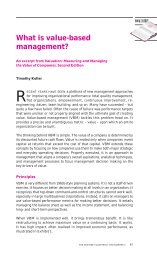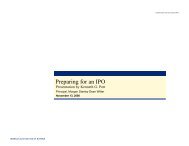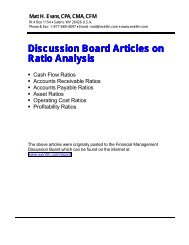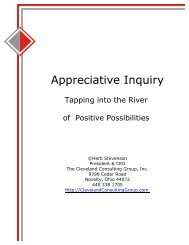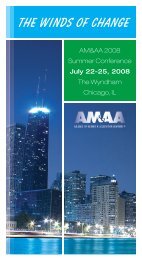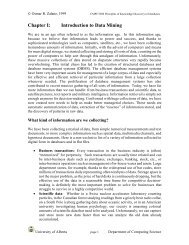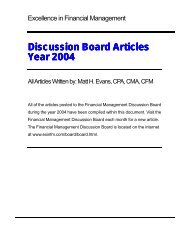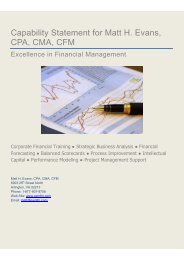Short Articles (PDF) - Excellence in Financial Management
Short Articles (PDF) - Excellence in Financial Management
Short Articles (PDF) - Excellence in Financial Management
Create successful ePaper yourself
Turn your PDF publications into a flip-book with our unique Google optimized e-Paper software.
What is Operat<strong>in</strong>g Leverage<br />
The use of fixed assets <strong>in</strong> generat<strong>in</strong>g earn<strong>in</strong>gs is referred to as operat<strong>in</strong>g leverage.<br />
Operat<strong>in</strong>g Leverage is measured by compar<strong>in</strong>g the change <strong>in</strong> profits to the change <strong>in</strong><br />
sales. Higher levels of operat<strong>in</strong>g leverage tend to result <strong>in</strong> wider variations <strong>in</strong> profits<br />
given a change <strong>in</strong> sales. This variation is called operat<strong>in</strong>g risks. Therefore, higher<br />
levels of fixed costs are often associated with high levels of operat<strong>in</strong>g risks which <strong>in</strong><br />
turn leads to fluctuations of earn<strong>in</strong>gs given a change <strong>in</strong> sales.<br />
Breakeven analysis is often used <strong>in</strong> conjunction with operat<strong>in</strong>g leverage. As we<br />
<strong>in</strong>crease sales beyond the breakeven po<strong>in</strong>t, the effects of operat<strong>in</strong>g leverage<br />
dim<strong>in</strong>ish s<strong>in</strong>ce the sales base we are us<strong>in</strong>g has <strong>in</strong>creased. We can use breakeven<br />
analysis to calculate operat<strong>in</strong>g leverage.<br />
Degree of Operat<strong>in</strong>g Leverage (DOL) = % Change <strong>in</strong> EBIT / % Change <strong>in</strong> Sales<br />
EXAMPLE: Price of Product = $ 10.00, Variable Cost per unit = $ 6.00, Fixed Costs =<br />
$ 12,000 and 5,000 units are sold.<br />
DOL = (($ 10.00 - $ 6.00) x 5,000) / ((($ 10.00 - $ 6.00) x 5,000) - $ 12,000) = 2.5<br />
What we can conclude from our calculation is that when sales <strong>in</strong>crease by say 10%,<br />
we can expect a 25% <strong>in</strong>crease <strong>in</strong> earn<strong>in</strong>gs s<strong>in</strong>ce we have operat<strong>in</strong>g leverage of 2.5.<br />
Thus, operat<strong>in</strong>g leverage gives us some measure of variations <strong>in</strong> earn<strong>in</strong>gs from<br />
changes to sales.<br />
What is Zero Work<strong>in</strong>g Capital<br />
Work<strong>in</strong>g capital is the comparison of current assets to current liabilities. For most<br />
organizations, current assets exceed current liabilities and work<strong>in</strong>g capital therefore<br />
represents the liquid reserves for meet<strong>in</strong>g current obligations. Creditors prefer high<br />
levels of work<strong>in</strong>g capital s<strong>in</strong>ce they are concerned about receiv<strong>in</strong>g payment.<br />
However, management prefers low levels of work<strong>in</strong>g capital s<strong>in</strong>ce work<strong>in</strong>g capital<br />
earns an extremely low rate of return. Some companies are now driv<strong>in</strong>g work<strong>in</strong>g<br />
capital to record low levels, so-called Zero Work<strong>in</strong>g Capital. By keep<strong>in</strong>g work<strong>in</strong>g<br />
capital at zero, funds are released for many other opportunities.<br />
Zero Work<strong>in</strong>g Capital requires major changes <strong>in</strong> how an organization functions. One<br />
way to implement Zero Work<strong>in</strong>g Capital is to have a demand-based organization.<br />
Demand-based organizations do everyth<strong>in</strong>g only as they are demanded: Fill<br />
customer orders, receive supplies, manufacture products, and other functions are<br />
done only as needed. The production facilities run 24 hours a day non-stop accord<strong>in</strong>g<br />
to the demands with<strong>in</strong> the marketplace. There are no <strong>in</strong>ventories; everyth<strong>in</strong>g is<br />
supplied immediately as needed. The end result of this demand driven organization<br />
is that little, if any, work<strong>in</strong>g capital is necessary to run the bus<strong>in</strong>ess.<br />
8



